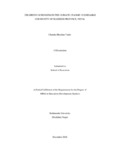
Please use this identifier to cite or link to this item:
https://hdl.handle.net/20.500.14301/530| Title: | Children’s Schooling in the Climate Change Vulnerable Community of Madhesh Province, Nepal. [Unpublished MPhil Disertation] |
| Authors: | Yadav, Chandra Bhushan |
| Citation: | Yadav, C.N.(2024).Children’s schooling in the climate change vulnerable community of madhesh province, Nepal. |
| Issue Date: | Dec-2024 |
| Publisher: | Kathmandu University School of Education |
| School: | SOED |
| Department: | DODE |
| Level: | M.Phil. |
| Program: | MPhil in Development Studies |
| Abstract: | Humans have started experiencing climate change disregards to their geographical location. The rise in the temperature of 1.1 degrees Celsius has altered most natural climatic phenomena into disasters. Moreover, because of climate change, the intensity and frequency of climatic disasters have increased worldwide, which has kept school children vulnerable because of more exposure, high sensitivity, and less adaptive capacity. With the increase in exposure to climatic disasters, the schooling of school children is at risk. School children from high vulnerable communities are primarily at the forefront of climatic disasters. Climatic disasters threaten school children in climate change-vulnerable communities as they cannot access their schools during those disasters. Their learning is also affected during disasters like floods, inundations, heat waves, and cold waves. Nepal's government has also identified each district's climate change vulnerability level and ranked each district based on the vulnerability score. The thesis entitled "Children's Schooling in the Climate Change Vulnerable Communities of Madhesh Province" aimed to see the relationship between climatic disasters and school children's schooling (access and learning). To meet the purpose of the study, the researcher formulated three research questions. The first research question intended to see the effect of climatic disasters on the schooling of school children. At the same time, the second research question focused on the effect of climatic disasters and demographic variables on school children. Similarly, the third research question helps to see the relationship between the schooling of schooling children and the climate change vulnerability of districts. The study was conducted in the two districts of Mahesh province. The researcher used a quantitative research method grounded on the post-positive research design. Under the quantitative research method, the researcher used a survey as a data collection approach. 336 children from 12 schools from two districts were selected for the data collection. Similarly, 12 schools and 336 children were selected based on the multistage random sampling methods from two districts of Madhesh province. Descriptive statistics, mean, correlation, cross-tabulation, chi-square, t-test, ANOVA, and logit regression analysis were used to analyze the data. Among them, 42% were male and 58% were female children. 25.3% of children belong to Terai Dalits communities, 3.9% from the Terai Bhramin community, 0.6% from Terai Janjatis communities, and 70.5% from the major ethnicity of Terai communities. Similarly, 95.2% of children were from the Hindu religion, and 4.8% were from the Islam religion. Only 2.4 of school children’s parents were earning more than NPR 100000. Majority of children parents’ monthly income was between NPR 20000 to NPR 50000. And most of the children’s family were engaged in agriculture. Floods, inundations, heat waves, and cold waves have moderate impacts on the access part of school children. Similarly, in the learning part of schooling, inundation, heat waves, and cold waves also have a moderate impact. The lowest impact was seen in the learning part during the flood and highest impact was during in learning during cold waves. Male children were facing more problems while going (access) to school in comparison to female school children during floods, inundations, heat waves and cold waves. In the learning part also, male children were more affected than female during flood, inundation, heat waves but not during the cold waves. Floods, heat waves, and cold waves were the reason for the male children's absenteeism. Male children seek family support to go to school during the heat waves times. Likewise, the access part of the schooling of school children the High Vulnerable (HV) district was more affected by the impact of climatic disasters than the Low Vulnerable (LV) district during a flood, heat waves, and cold waves but not during inundation. Further, the learning of school children from the HV district was also more affected by the climatic disaster during inundation, heat waves and cold waves but not during the flood. The result of logit regression shows that, access and learning during the heat waves was less affected in the low climate change vulnerable district than access and learning of school children from high climate change vulnerable district. In conclusion, climatic disasters have affected the schooling of school children. The schooling of school children was aligned with the climate change vulnerability level of the district. Which means that the schooling of school children was more affected by the climatic disasters who belong to a more vulnerable district. More research needs to be done to explore the impact of climatic disasters and schooling in the coming days. Inclusive implementation of the national climate change policy is recommended for the better schooling of school children. Further, school communities need to be aligned with the national climate change policy and develop relevant adaptation strategies against the climatic disasters that affect the schooling of school children. As climate change is dependent on the geographical locations, most vulnerable communities need to develop their own plans and policies to overcome the implication of climate change. |
| URI: | https://hdl.handle.net/20.500.14301/530 |
| Appears in Collections: | Dissertations |
Files in This Item:
| File | Description | Size | Format | |
|---|---|---|---|---|
| Chandra_Thesis_Final 10_Feb (1).pdf | 3.05 MB | Adobe PDF |  View/Open |
Items in DSpace are protected by copyright, with all rights reserved, unless otherwise indicated.